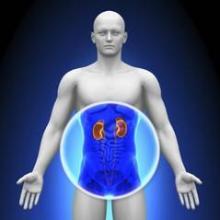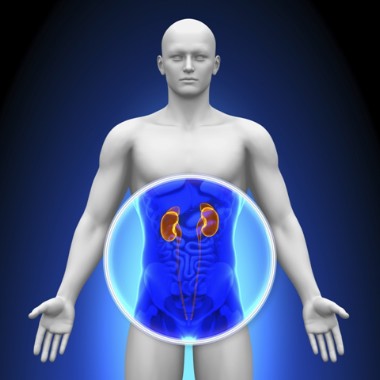User login
Men who had glomerular disease as children were at increased risk for developing hypertension as adults, according to a study published in JAMA.
Dr. Asaf Vivante and his colleagues studied 38,144 healthy men in the Staff Periodic Examination Center (SPEC) of the Israeli Defense Forces Medical Corps, 264 of whom had a medical history of resolved childhood glomerular disease.
All participants had a baseline evaluation at age 17, during which the diagnosis of resolved childhood glomerular disease (including childhood acute glomerulonephritis and nephrotic syndrome) was determined. Men with unresolved childhood glomerular disease, hypertension, diabetes, active rheumatic diseases, or any other kidney or urinary tract disorders were excluded. SPEC follow-up visits occurred until hypertension diagnosis, retirement from service, or Dec. 31, 2010, whichever came first.
At a mean follow-up of 18 years, 2,856 men developed hypertension. Of men with a history of resolved childhood glomerular disease, 13.6% had hypertension as adults, compared with 7.4% who had no childhood kidney disease (hazard ratio, 1.67; 95% confidence interval, 1.20-2.31; P = .002 when adjusted for age and body mass index) (JAMA 2014;311:1155-7).
The researchers cited a few limitations of the study, including a lack of information on the exact glomerular histopathologic injury during childhood and the young age of the study population at the end of follow-up.
Database access was provided by the Israeli Defense Forces Medical Corps. One coauthor reported receiving travel reimbursement from the European Cooperation in Science and Technology. No other disclosures were reported.
Men who had glomerular disease as children were at increased risk for developing hypertension as adults, according to a study published in JAMA.
Dr. Asaf Vivante and his colleagues studied 38,144 healthy men in the Staff Periodic Examination Center (SPEC) of the Israeli Defense Forces Medical Corps, 264 of whom had a medical history of resolved childhood glomerular disease.
All participants had a baseline evaluation at age 17, during which the diagnosis of resolved childhood glomerular disease (including childhood acute glomerulonephritis and nephrotic syndrome) was determined. Men with unresolved childhood glomerular disease, hypertension, diabetes, active rheumatic diseases, or any other kidney or urinary tract disorders were excluded. SPEC follow-up visits occurred until hypertension diagnosis, retirement from service, or Dec. 31, 2010, whichever came first.
At a mean follow-up of 18 years, 2,856 men developed hypertension. Of men with a history of resolved childhood glomerular disease, 13.6% had hypertension as adults, compared with 7.4% who had no childhood kidney disease (hazard ratio, 1.67; 95% confidence interval, 1.20-2.31; P = .002 when adjusted for age and body mass index) (JAMA 2014;311:1155-7).
The researchers cited a few limitations of the study, including a lack of information on the exact glomerular histopathologic injury during childhood and the young age of the study population at the end of follow-up.
Database access was provided by the Israeli Defense Forces Medical Corps. One coauthor reported receiving travel reimbursement from the European Cooperation in Science and Technology. No other disclosures were reported.
Men who had glomerular disease as children were at increased risk for developing hypertension as adults, according to a study published in JAMA.
Dr. Asaf Vivante and his colleagues studied 38,144 healthy men in the Staff Periodic Examination Center (SPEC) of the Israeli Defense Forces Medical Corps, 264 of whom had a medical history of resolved childhood glomerular disease.
All participants had a baseline evaluation at age 17, during which the diagnosis of resolved childhood glomerular disease (including childhood acute glomerulonephritis and nephrotic syndrome) was determined. Men with unresolved childhood glomerular disease, hypertension, diabetes, active rheumatic diseases, or any other kidney or urinary tract disorders were excluded. SPEC follow-up visits occurred until hypertension diagnosis, retirement from service, or Dec. 31, 2010, whichever came first.
At a mean follow-up of 18 years, 2,856 men developed hypertension. Of men with a history of resolved childhood glomerular disease, 13.6% had hypertension as adults, compared with 7.4% who had no childhood kidney disease (hazard ratio, 1.67; 95% confidence interval, 1.20-2.31; P = .002 when adjusted for age and body mass index) (JAMA 2014;311:1155-7).
The researchers cited a few limitations of the study, including a lack of information on the exact glomerular histopathologic injury during childhood and the young age of the study population at the end of follow-up.
Database access was provided by the Israeli Defense Forces Medical Corps. One coauthor reported receiving travel reimbursement from the European Cooperation in Science and Technology. No other disclosures were reported.
FROM JAMA
Major finding: Of men with a history of resolved childhood glomerular disease, 13.6% developed hypertension as adults, compared with 7.4% of men who had no childhood kidney disease (hazard ratio, 1.67; 95% confidence interval, 1.20-2.31; P = .002 when adjusted for age and body mass index).
Data source: An analysis using Cox proportional hazards models of 38,144 healthy men in the Staff Periodic Examination Center (SPEC) of the Israeli Defense Forces Medical Corps, 264 of whom had a history of resolved childhood glomerular disease.
Disclosures: Database access was provided by the Israeli Defense Forces Medical Corps. One coauthor reported receiving travel reimbursement from the European Cooperation in Science and Technology. No other disclosures were reported.

